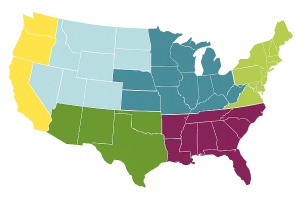New Mexico Native Plants, State Flower & State Bird
Posted By American Meadows Content Team on Sep 27, 2012 · Revised on Oct 26, 2025

Knowing your location helps us recommend plants that will thrive in your climate, based on your Growing Zone.
Posted By American Meadows Content Team on Sep 27, 2012 · Revised on Oct 26, 2025
Native plants are adaptable, low-maintenance, and beautiful. They are the best choice for habitat-friendly gardens and thriving ecosystems. Find top picks for native plants in your state - and learn about your state bird and state flowers!
Follow Along With More Of Our Guides
Hello native plant enthusiasts! In the list below, you will find popular native plants and wildflower seeds, available from American Meadows, that have a native distribution in your state. You’ll also find information about your state bird, state flower, and state wildflower!
Grow our Native Southwest Wildflower Seed Mix
Showy Goldenrod (Solidago speciosa)
Black Eyed Susan or Gloriosa Daisy (Rudbeckia hirta)
Giant Black Eyed Susan (Rudbeckia maxima)
Yellow Prairie Coneflower (Ratibida columnifera)
Butterfly Weed (Asclepias tuberosa)
Swamp Milkweed (Asclepias incarnata)
Firewheel (Gaillardia pulchella)
Blanket Flower (Gaillardia aristata)
Wild Strawberry (Fragaria virginiana)
Plains Coreopsis (Coreopsis tinctoria)
Lanceleaf Coreopsis (Coreopsis lanceolata)
California Poppy (Eschscholzia californica)
Wild Bergamot (Monarda fistulosa)
Wild Geranium (Geranium maculatum)
Elderberry (Sambucus canadensis)
Obedient Plant (Physostegia virginiana)
Red Cardinal Flower (Lobelia cardinalis)
Meadow Anemone (Anemone canadensis)
Bottlebrush Grass (Elymus hystrix)
Big Bluestem (Andropogon gerardii)
Little Bluestem (Schizachyrium scoparium)
Tufted Hair Grass (Deschampsia cespitosa)
Northern Sea Oats (Chasmanthium latifolium)
Yellow Prairie Grass (Sorghastrum nutans)
Aromatic Aster (Symphyotrichum oblongifolium)
New England Aster (Symphyotrichum novae-angliae)
Common White Yarrow (Achillea millefolium)

Roadrunner ~ Geococcyx californianus
The rattlesnake strikes repeatedly, but the Roadrunner dodges. The snake tires, and the big bird dances in, stabs at the reptile’s head with its long beak, thrashes it on a rock and begins to feed on it. So goes mealtime for the Roadrunner to whom the desert is home, and almost anything that moves is food. New Mexicans say the X-like tracks of this strange bird confuse the Devil, who can’t tell which way the bird has fled. For a short stretch a Roadrunner can sprint twenty miles an hour. Early travelers along the Santa Fe Trail first noticed the “chaparral cock” in the wagon ruts, and nicknamed it the Roadrunner.
Yucca Flower ~ Yucca elata
Of the seven varieties of Yucca that grow in abundance in New Mexico, the stately Yucca elata is one of the most elegant. In the early summer, pale ivory flowers bloom at the tips of its long fibrous stalks. At the base of the plant are broad, sharp-edged leaves that look like stilettos. Its roots were ground into an excellent substitute for soap called amole by the Indian and pioneer women. The Yucca has a remarkable method of pollination. Moths, attracted to the Yucca’s perfume, fly from plant to plant transferring pollen.
From The Wildflowers of the 50 States U.S. stamps issued July 24, 1992:

